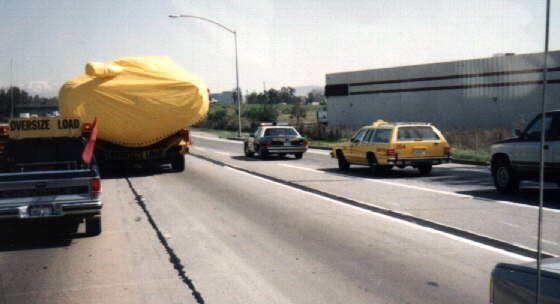How do really big, unusual loads move around our nation? On the freeway, how else! You never can tell what's right next to you, barreling down the multi-lane freeways or back roads of America. This page will show you my involvement with moving the nation's most complex unmanned satellite launch vehicle, Atlas.
I was fortunate enough to have worked on Atlas Space Launch vehicles at Vandenberg Air Force Base on the central coast of California. We would pick up bare propellant tanks in San Diego, the home of General Dynamics' Space Systems Division, and trailer them over the road through Los Angeles, Santa Barbara, and onto the base near Lompoc. After buildup, the rockets were returned to San Diego, where they were loaded onto a C-5 for the flight to Florida for launch. The roads we would use varied, depending on road construction projects, and the height of overpasses along various routes, as the load was over normal height, width, and length restrictions.

The photo above is a bare Atlas tank heading north along Highway 101, between Ventura and Santa Barbara. The trailers are so long that two drivers must ride in the trailer to steer the rear wheels when slow, sharp corners are encountered. You can see one driver with his door open just in front of the trailer tires. Most of the time, they just ride along with the steering locked straight ahead. The driver on the left has a double task. He must monitor the nitrogen gas pressure in the hollow Atlas propellant tanks. Atlas is like a long skinny balloon, with no internal or external bracing. The gas pressure inside (12-15 psi in the rear fuel tank, 6-9 psi in the front oxidizer tank) is all the keeps the structure from collapsing. Lose that pressure during transportation, and the rocket is ruined
Somehow, it worked out that I was the main transportation engineer of the six mechanical test engineers at the assembly facility. This might be due to my automotive background, or maybe because of what happened on one of my early trips from San Diego to Vandenberg. It was during one of these northbound trips that something very rare in the rocket transportation business happened--we had a flat tire, on the transition from the 210 freeway to the 118 freeway in San Fernando, in the northern part of Los Angeles' San Fernando Valley.
It wasn't just any flat, but a major blowout. We stopped on the overpass to San Fernando Road, which was the first wide spot we could find. We got out to check the damage, and found that the flying chuncks of rubber took out the air brake hose on the trailer, making the trailer impossible to move. There we were, multi-million dollar rocket, stuck on an overpass. But we got lucky. I looked around to see where we were, and it just happened that there was a Ford tractor dealer less than a block away. What great luck. While the crew changed the tire, I ran down to the tractor place and explained my predicament. They made us a new hose, sold us a new fitting, and loaned us a tool to remove the broken fitting on the air brake pod. We were back on the road in about an hour. I suppose that my bosses realized if I could handle that problem, that anything else would be cake.

Here we are with a completed Atlas II rocket on the side of Highway 126, a two-lane road between Highway 101 and Interstate 5, during a rest break. We would always try to stop for breaks somewhere outside the limits of Los Angeles, for safety reasons. You can really get a sense for how long and wide this thing is. It is about 120 feet long and over 14 feet wide! One of the tillermen, the two guys in the back, is about to get into his pod on the passenger side.

It really gets exciting when traffic is heavy. Just think about it: You're in charge of a 50 million dollar rocket, which, if damaged, can cause delays in military and commercial launches, and could cost your employer hundreds of millions of dollars in losses of hardware and launch delays. Launch delays could also affect national security. These are the times that you really appreciate the California Highway Patrol. We only had police escorts in high traffic areas such as this, which is Interstate 10, near Pomona. They would pick us up in Ventura, and drop us off outside Corona. We only had escorts on southbound trips, when the rocket was way over width restrictions. We would travel at the posted speed limits, but people would always be passing us. It was terrifying to think about what might happen if some driver were to get distracted and crash into our rocket where it overhung the trailer. Because of the engines, the back end is the most expensive part of any rocket, and during transportation, the most vulnerable.
It certainly was an exciting job.
